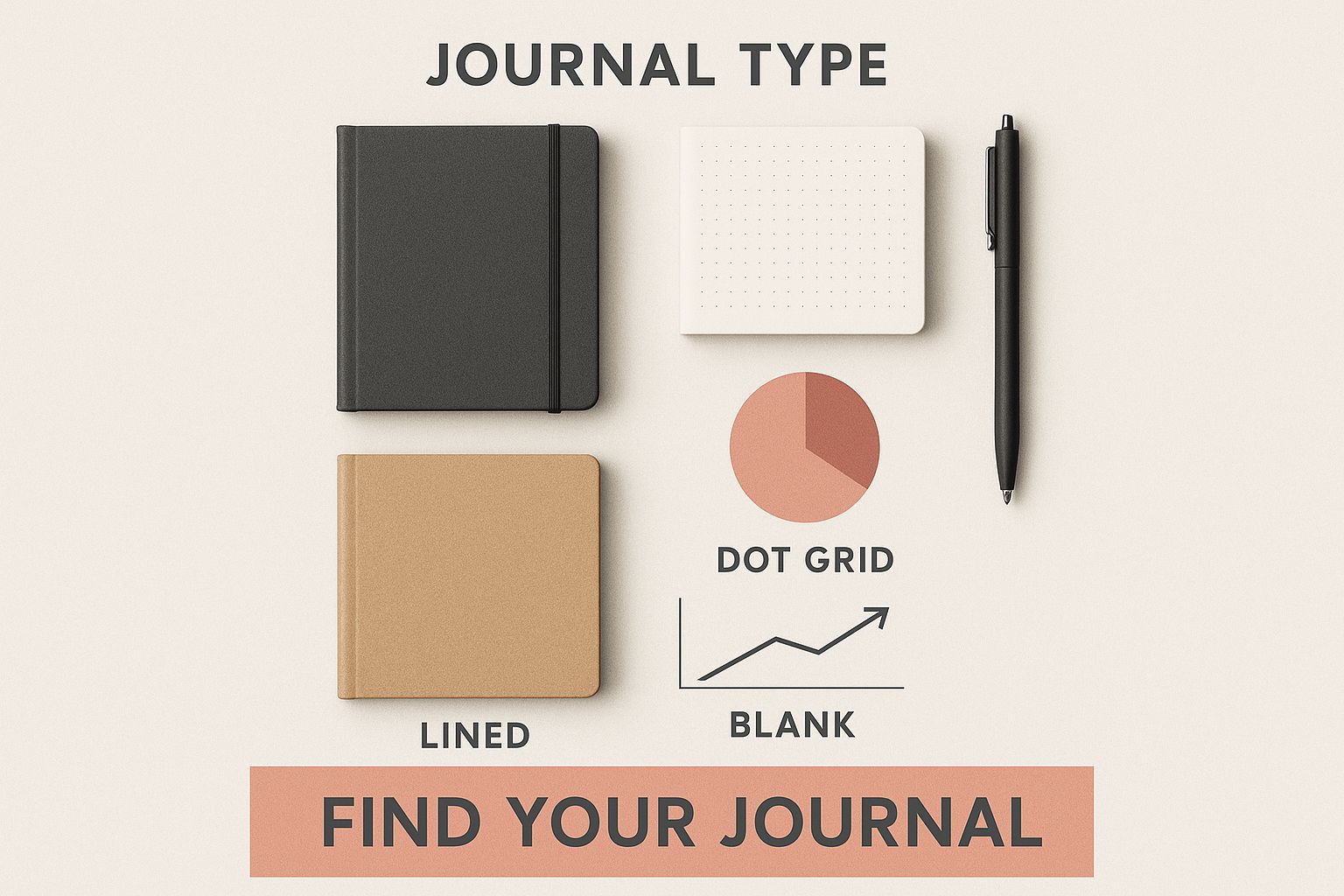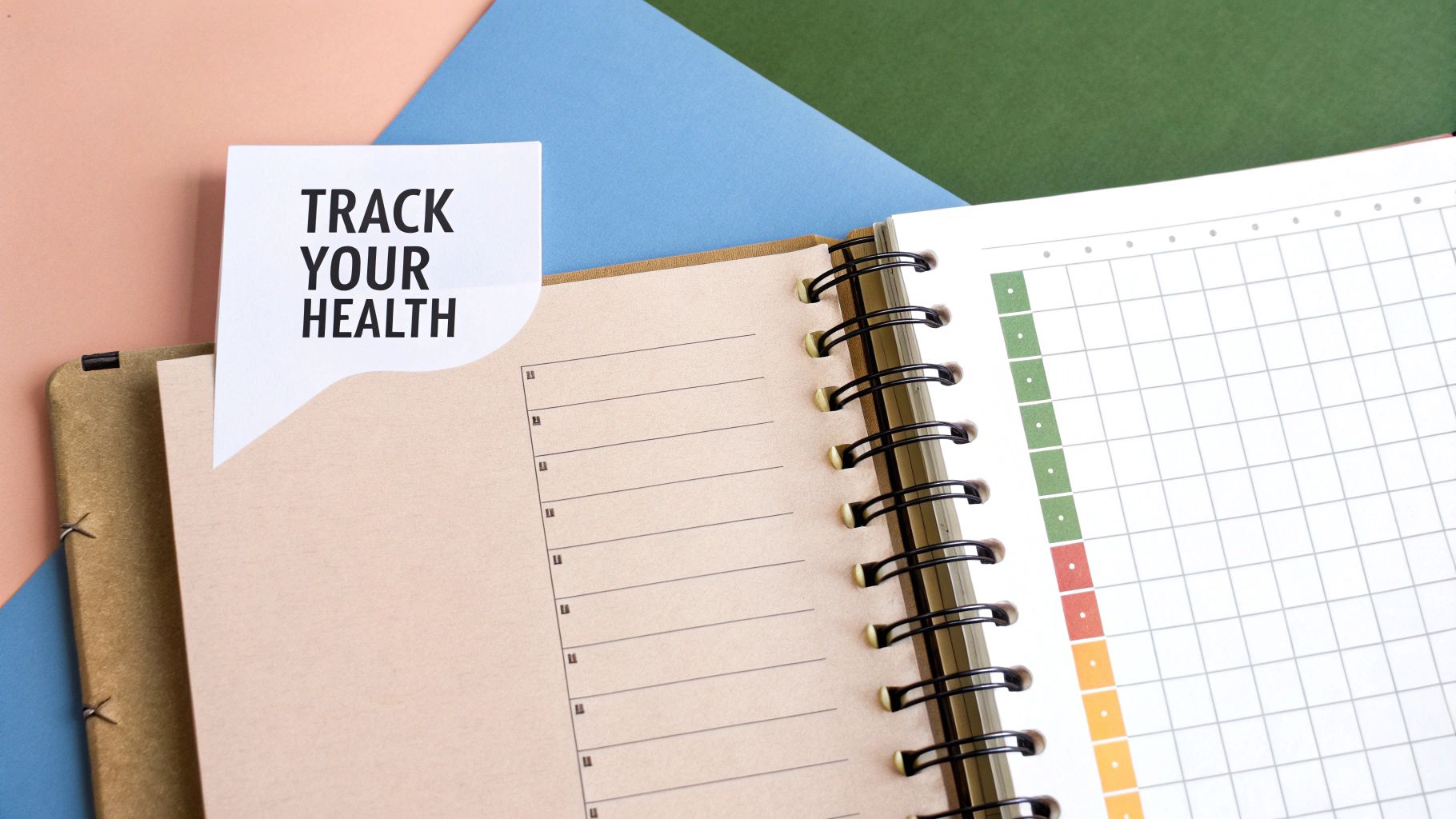Imagine a personal command center for your well-being. That's a health and wellness journal. It’s not just a diary; it's a dedicated space where you can track your physical health, tune into your emotional state, and map out your goals. It’s where you align your daily actions with your biggest aspirations for a vibrant life.
Starting Your Journey to a More Mindful You
Welcome to a practice that can genuinely reshape your life. Starting a health and wellness journal is a powerful act of self-care—a private space where you can connect with yourself, understand your patterns, and celebrate every bit of progress. It’s the tool that helps you shift from simply wishing for better health to actively creating it, one entry at a time. This simple yet profound habit can spark incredible shifts in both your mental and physical health.

Why Wellness Matters Now More Than Ever
The world has woken up to the importance of personal well-being. It's no longer a niche interest but a vital part of our collective conversation. In fact, the global wellness economy was valued at an incredible $6.3 trillion in 2023. Sectors like healthy eating, fitness, and mental wellness show a massive worldwide commitment to living healthier lives.
Your journal is your personal dashboard in this landscape. It helps you navigate your unique journey by making abstract goals feel concrete and measurable. If you're just getting started, our guide on how to start journaling offers simple, actionable steps to make the process feel natural and rewarding from day one.
Building Your Personal Sanctuary
Think of your journal as a sanctuary—a private, judgment-free zone where you can be completely honest with yourself. This is the place to untangle jumbled thoughts, document your wins (no matter how small!), and get clear on what truly nourishes your body and soul.
Your health journal is not about achieving perfection. It's about fostering a deeper connection with yourself, understanding your needs, and honoring the journey of becoming the healthiest version of you.
This practice isn't another chore. It's a cherished ritual. To give you a better idea, let's break down the core components you might track.
Key Dimensions of a Health and Wellness Journal
The table below breaks down the core components you can track in your journal to create a holistic view of your well-being.
| Dimension | What to Track | Why It Matters |
|---|---|---|
| Physical Health | Nutrition, exercise, sleep quality, energy levels, water intake, symptoms. | Helps you connect your daily habits to how your body feels, identifying what fuels you and what drains you. |
| Emotional Well-being | Moods, gratitude lists, stress triggers, moments of joy, affirmations. | Builds emotional awareness, helping you recognize patterns and cultivate a more positive mindset. |
| Personal Growth | Intentions, habit tracking, goals, milestones, reflections on challenges. | Provides a clear record of your progress, keeping you motivated and focused on the person you want to become. |
By dedicating just a few minutes each day to these areas, you start building a powerful foundation for lasting change. You’re not just writing in a book; you're actively authoring a healthier, more mindful chapter of your life.
The Science-Backed Benefits of Journaling
Beyond the simple joy of putting pen to paper, keeping a health journal is a practice rooted in real, science-backed benefits. It’s an active form of self-care that lets you become the architect of your own well-being, turning abstract feelings into concrete, actionable insights.
This isn’t just about documenting your day; it’s about engaging in a process that actively improves your health. The act of writing is a powerful tool for clarity and control, helping you untangle complex emotions and identify the root causes of stress in a private space.
This commitment to personal wellness is part of a larger movement. In the United States, self-care has become a cornerstone of a healthy lifestyle. Surveys show that roughly 9 out of 10 Americans regularly practice self-care. With a growing awareness around mental health, many have increased these efforts, making habits like journaling more important than ever. You can discover more about these health and wellness industry statistics and see just how big this shift is.
Reduce Stress and Cultivate Calm
One of the most immediate benefits of expressive writing is its incredible impact on stress. When you journal about your feelings, you're not just venting—you're actively processing them. Studies show this can lead to a measurable drop in cortisol, the body's main stress hormone.
Practical Action Point:
- Feeling overwhelmed? Take 15 minutes to write down everything on your mind without censoring yourself. This practice, known as a "brain dump," can lower blood pressure and create an immediate sense of calm.
Think of your mind like a browser with too many tabs open. Journaling helps you close them one by one, creating mental space. By getting your worries onto the page, you shift from chaotic reaction to thoughtful response, cultivating more inner peace.
Enhance Your Self-Awareness
Ever feel stuck in a rut, not quite sure why you're so tired or unmotivated? A health and wellness journal acts as a mirror, reflecting patterns you might otherwise miss.
By consistently tracking your mood, energy levels, and daily habits, you start to see powerful connections. You might discover your afternoon slump is tied to your lunch, or that anxiety spikes on days you skip your morning walk. This isn't guesswork; it's data-driven self-discovery.
Journaling gives you the power to become your own health detective. It helps you connect the dots between your actions and their consequences, empowering you with the knowledge to make conscious, positive changes.
This heightened awareness is the most critical step toward meaningful transformation. It allows you to address the root cause of your issues instead of just the symptoms, leading to more sustainable improvements in your life.
Achieve Your Goals with Greater Success
Writing down your goals makes them real. Research shows that people who write down their goals are significantly more likely to achieve them. A health and wellness journal provides the perfect home for this powerful practice.
Whether your goal is to run a 5K or eat more whole foods, your journal becomes your roadmap.
Practical Action Points:
- Define Your Path: Write down what you want to achieve and, more importantly, why it matters to you.
- Break It Down: Use your journal to create small, manageable steps.
- Celebrate Milestones: Document your wins, no matter how small! This builds momentum and keeps you inspired.
By regularly engaging with your dreams on paper, you keep them front and center in your mind. Your journal becomes a beautiful testament to your commitment and a source of inspiration on your journey.
Choosing the Right Journal for Your Lifestyle
Finding the perfect health and wellness journal is like choosing a trusted friend—the best one is the one that fits you perfectly. There is no one-size-fits-all answer. Your ideal journal should feel like a natural extension of who you are and slide seamlessly into your life.
The goal isn't just to find a journal; it's to find your journal. The right tool will make you genuinely excited to show up for yourself each day, turning a simple practice into a cherished ritual. Let's explore the options to help you find your perfect match.
This infographic gives a quick look at the main options to help you find your journal.

As you can see, the choice between digital, guided, and blank journals comes down to what you value most—convenience, structure, or creative freedom.
To make things even clearer, let's break down the different journaling styles.
Choosing Your Journaling Style
This table compares the different journaling methods to help you find the best fit for your lifestyle and goals.
| Journal Type | Best For | Pros | Cons |
|---|---|---|---|
| Blank Notebook | Creative minds, artists, and anyone who loves designing their own system from scratch. | Offers total flexibility, encourages creativity, and can be deeply personal. You make the rules! | The blank page can feel intimidating at first. It requires more effort to set up and maintain. |
| Guided Journal | Beginners, or anyone who wants a clear framework and daily prompts to get them started. | Removes the guesswork, provides helpful structure, and makes building a habit feel easy. | The pre-set format might feel a bit restrictive if you want to go off-script. |
| Digital App | Tech-savvy people, those who are always on the go, or anyone who enjoys analyzing their progress. | Super convenient, easily searchable, offers data tracking, and provides helpful reminders. | A screen can feel less mindful for some, and it’s easy to get distracted by other notifications. |
Each style has its own magic. It’s all about finding the one that speaks to you and makes you want to keep coming back to the page.
The Blank Notebook for Creative Freedom
The classic blank notebook is a canvas for your imagination. It offers complete freedom, making it the perfect choice for creative spirits and anyone who prefers to build their own system from the ground up. If you love bullet journaling, mind mapping, or letting your thoughts flow without constraints, this is your path. You are in 100% control of the content, layout, and style.
Guided Journals for Structure and Simplicity
For those of us who could use a gentle nudge, a guided journal is a perfect companion. These journals come with pre-designed layouts and daily prompts, taking all the guesswork out of the process. They often focus on specific areas like gratitude or fitness, giving you a clear framework. It's like having a friendly coach who asks you the right questions every day, making a new habit feel effortless.
Guided journals are fantastic for removing the initial friction of journaling. They provide the scaffolding you need to build a strong foundation, making it easy to start and even easier to continue.
Think of it as journaling with training wheels. It gives you the support you need until you feel confident enough to create your own path.
Digital Apps for Convenience and Data
In our modern lives, convenience is everything. Digital journaling apps, available on your phone or tablet, make it incredibly easy to log entries anytime, anywhere. Plus, they offer powerful features a physical journal can't match, like data tracking, charts of your moods, and helpful reminders. This makes them perfect for the data-driven person who loves seeing tangible progress.
Ultimately, the best health and wellness journal is the one you will actually use consistently. Whether you crave the freedom of a blank page, the support of a guided structure, or the convenience of a digital app, choose the tool that inspires you to connect with yourself every single day.
What to Track for a Holistic View of Your Health
Opening your journal for the first time can feel like staring at a blank map—exciting, but where do you begin? The wonderful truth is there are no wrong answers. Think of this as your personal toolkit, filled with ideas you can mix and match to create a practice that feels uniquely you.
Don't feel pressured to track everything at once. The real magic happens when you choose a few areas that resonate with you right now and build from there. This is about shining a gentle light on the parts of your life that matter most.

Nourishing Your Physical Well-Being
Your body is in constant conversation with you. A journal is your way of learning its language, connecting what you do each day to how you physically feel. This is where you start to see those powerful “aha!” moments that empower you to make smarter choices.
Practical Action Point:
- Start by tracking just one thing for a week, like your water intake or sleep quality. Notice how small changes affect your energy. You might discover that better hydration eliminates your afternoon slump!
Simple Prompts for Physical Health:
- Nutrition: "What foods made me feel energized today?" For many, understanding your digestive system is a game-changer; these tips on improving gut health can give you ideas on what to monitor.
- Exercise: "How did it feel to move my body?" This is less about the miles logged and more about the feeling of movement.
- Sleep: "Did I wake up feeling refreshed or tired?" You might find that quality trumps quantity.
By jotting down these simple details, you’ll begin to notice clear patterns and gain powerful insights that lead to lasting change.
Tuning Into Your Mental and Emotional Landscape
Your inner world is just as vital as your outer one. Think of your journal as a safe space to explore your thoughts and feelings without judgment. It’s here that you can build emotional resilience and cultivate a more positive mindset by acknowledging all of your emotions.
Your journal is your emotional compass. Use it to navigate your feelings, identify what fuels your joy, and gently guide yourself toward a state of greater inner peace.
Practical Action Point:
- Try the "Three Good Things" exercise. At the end of each day, write down three specific things that went well and why. This simple habit, backed by positive psychology, trains your brain to notice the good.
Consider weaving these practices into your journaling:
- Gratitude Lists: What are you thankful for today?
- Stress Triggers: When you feel overwhelmed, note what was happening. This helps you manage stressors.
- Moments of Joy: Make a note of small wins and happy moments to look back on.
These practices aren't about forcing happiness. They’re about training your mind to see the good that is already there.
Fostering Personal Growth and Intentional Living
Finally, your journal can be an incredible partner in your personal growth, helping you move from being a passive observer to an active creator of your life. This is where you set intentions, celebrate progress, and hold yourself accountable to the person you want to become.
A habit tracker is a game-changer. Whether your goal is to drink more water or meditate for five minutes, a tracker gives you a visual snapshot of your consistency. Watching those checkmarks add up is incredibly motivating.
Action Points for Personal Growth:
- Set a Weekly Intention: At the start of the week, write down one simple focus, like "I will be more present."
- Track One Key Habit: Pick just one new habit to focus on. Celebrate every day you stick with it!
- Reflect on Challenges: When you miss a day, write about what got in the way and what you learned. This builds resilience.
By combining these elements—physical, emotional, and personal—you create a rich picture of your life. Your journal becomes a living document of your journey toward a healthier, more intentional you.
How to Build a Journaling Habit That Lasts
You've picked out the perfect journal, but a powerful tool is only useful if you actually use it. The real magic of journaling comes from consistency. Building that habit isn’t about willpower; it's about weaving this practice into your life so it becomes a cherished ritual, not a chore.
The goal is to make journaling feel effortless. This is more important than ever, with global fitness club memberships reaching nearly 77 million worldwide. This boom reflects a bigger movement of people actively bringing wellness into their daily lives, and journaling is a cornerstone of this lifestyle. You can learn more about this on the GlobalWellnessInstitute.org.
Start Small and Be Kind to Yourself
The biggest roadblock to a new habit is feeling like you have to do it perfectly. Let go of that pressure! The best way to begin is to make it so easy you can’t say no.
Practical Action Point:
- Commit to just five minutes a day. Set a timer. Write three things you’re grateful for or what you ate for lunch. The length is less important than the act of showing up for yourself daily.
This small, consistent action builds momentum and creates the foundation for a habit that truly sticks.
Anchor Your Habit to an Existing Routine
Habit stacking is a powerful technique. The idea is simple: link your new journaling habit to something you already do every day.
Here are a few examples:
- Morning Coffee: "After I pour my coffee, I will journal for five minutes."
- Brushing Your Teeth: "Right after I brush my teeth at night, I will open my journal."
- Getting Into Bed: "Before I turn out the light, I will write one good thing that happened today."
By piggybacking on an existing routine, you remove the need to find extra time or motivation. For more great ideas, check out our guide on how to journal effectively.
Create an Inspiring Journaling Environment
Your surroundings have a huge impact on your motivation. Designate a special, inviting space for your journaling practice. A cozy corner or a clear spot on your desk can signal to your brain that it’s time to reflect.
Make it a sensory experience. Light a candle, play calming music, or sip warm tea. Having a beautiful pen can turn the experience from a chore into a treat, making you genuinely excited for it each day.
Your journaling practice is a sacred appointment with yourself. Treat it with the same importance you would a meeting with a dear friend—create a space that feels warm, welcoming, and completely yours.
To make sure your new routine becomes permanent, explore strategies for building healthy habits that actually stick.
Overcome Perfectionism and Find Your Flow
Remember, your journal is for your eyes only. It’s a judgment-free zone. Let go of worries about grammar, spelling, or having a profound insight every time you write.
Some days, you might fill pages. Other days, you might only manage a single sentence. Both are perfectly okay. The goal is connection, not perfection. If you miss a day, don't beat yourself up. Just pick it back up the next. The most important step is always the next one you take.
Your Journaling Questions, Answered
Starting something new always brings up questions, which is a wonderful sign that you're curious and ready to dive in. Let’s tackle some of the most common queries about health and wellness journaling so you can start with total confidence.
How Long Should I Spend Journaling Each Day?
There’s no magic number. The power of journaling is in consistency, not duration. Forcing yourself to write for 30 minutes when you only have ten can turn a peaceful ritual into a chore.
Commit to just 5-10 minutes a day. Use that time to jot down your meals, list three things you’re grateful for, or answer a single thoughtful prompt. The goal is to build a habit you look forward to.
As you get comfortable, you might naturally want to write for longer. Let your practice grow at its own pace. This is your personal sanctuary, not a performance.
What If I'm Not a Good Writer?
Let's get one thing straight: your journal is a 100% judgment-free zone. It’s for your eyes only. You aren't writing a bestseller; you're having a conversation with yourself. So, any worries about being a "good writer" can be left at the door.
Perfectionism is the biggest hurdle. The moment you let that go, you unlock the true freedom of the practice.
Easy Ways to Journal Without "Writing":
- Use bullet points: Simply list out your thoughts, feelings, or events.
- Create lists: Make a quick list of your energy levels, small wins, or things that made you smile.
- Draw or doodle: A simple sketch can capture a feeling better than words.
- Use prompts: Let a prompt guide you. Ask yourself: "How does my body feel right now?"
The only "right" way to journal is the way that works for you. Your unique voice is what makes it so powerful.
Is a Digital Journal Better Than a Physical One?
Neither one is better—the best choice comes down to your lifestyle and what feels most natural to you.
A physical journal offers a tangible, screen-free experience that many find incredibly mindful. The act of putting pen to paper can be meditative, helping to slow racing thoughts and deepen your connection with yourself.
On the other hand, digital journals are all about convenience. They’re always with you on your phone, making it easy to capture a thought on the go. They often come with handy features like data tracking and reminders. The key is to pick the tool that feels inspiring, not like a chore. Don't be afraid to try both and see which one you stick with!
How Soon Will I See the Benefits?
What a beautiful question! It shows you're ready for positive change. Some benefits, like a sense of clarity after writing, can be almost immediate. It’s like tidying up a cluttered room—you instantly feel better.
The deeper, more profound changes unfold over time with consistent practice.
Think of journaling like planting a seed. You won't see a full-grown tree overnight, but with steady care, the roots take hold. You might feel less stressed within a few weeks, while bigger shifts in self-awareness can develop over a month or more.
Be patient and kind to yourself. Every entry is a small act of nourishment for your well-being. Trust the process, and one day you’ll look back and be amazed at how far you've come, one page at a time.
At Mesmos, we believe in the power of small, intentional acts to create a life of beauty and significance. Our thoughtfully designed journals and wellness products are created to be your companions on this journey, turning self-care into a cherished ritual. Discover the perfect tool to start your practice and inspire your path to inner peace.
Explore our collection at https://mesmos.co and find something that speaks to your soul.
